Behind The Scenes Film
This interview with Brian Johnson was shot during the filming of Seed Of Destruction, around July 1976. All the DVDs contain the interview, including Carlton Year 2 volume 6, A&E volume 16, followed by the model shop footage. The footage of the storyboards and Johnson interview is 8 minutes, 15 seconds. A slightly shorter version, 6 minutes 42 seconds, is on the Network Second Series DVD and Blu-ray. A much shorter 3 minute 21 second version (without the storyboards) is on the 2019 US Shout! Factory Blu-ray. There is additional footage on the Space: 1999 Documentary (Kindred, 1996), which has not been released commercially.
This is edited extracts from the interview.
This is the first of five shots we're going to do today- Eagle One orbiting the asteroid.
Some shots of the Seed Of Destruction storyboard; scenes 73, 61, 63, and two Big Screen-framed shots, 66 and 69. Note the actual shots (below) are not exactly the same as the storyboards. The shot of the underside of the Eagle illuminated by green light is scene 73. It was obviously filmed (the Eagle is set up for the shot), but does not appear in the final episode.
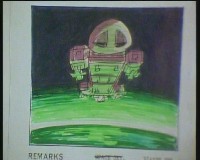
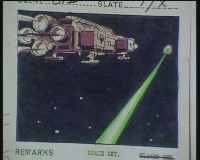


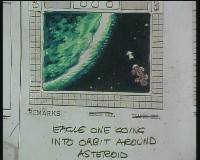

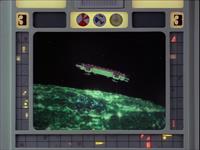
We're in the process of shooting a shot of the Eagle approaching the planet. We have to do this by making a number of exposures. The first exposure we do is on the Eagle. And the second exposure is on the planet. We combine the two exposures on one piece of film by rewinding the camera.
The sequence is developed in a number of ways. We choose the most similar types of shots and do those in one go, doing the various exposures on the planets or the asteroids, and then the various exposures on the Eagles, being very careful to wind back the film and expose the correct Eagle on the correct planet shot.
The first stage is to shoot the Eagle. That's the most difficult component in the shot. So we line that up and shoot it first, and that way we gauge the length the shot should actually be.
You designed the Eagle. What were your theories behind it?
I based it on an insect appearance. I have a thing about space models being quite similar in appearance to insects. Just the same way that Concorde is very insect like in certain profiles. It's not quite like a grasshopper but it is nevertheless insect like.
The third 44 inch Eagle model is seen in detail. Note the lack of detailing above the pod door.
The series is long running, therefore we have to use the Eagle a number of times. So we have to make it out of durable things like brass tubing, high density foams, perspex and very expensive hardwoods. They cost about three and a half thousand pounds each.
The biggest one we have is this 44 inch Eagle, in its complete form. We have three of those. Three 22 inch Eagles, two 11 inch and one 5 1/2. And we've got enlarged sections of the main legs and some of the girder-work, which is considerably bigger, but not the thing as a whole.
There were actually just two 22 inch Eagles, not three.
How long would it take to build this size of Eagle from scratch?
It takes about 6 weeks. Quite a few man hours because the brass tubing is very intricately put together. Every piece has to be filed and fitted.
It weighs about 35 pounds. We have to support it from either end, and from underneath and on top, so we have to build a number of rigs to do each individual shot. They're either supported on wires, or on poles that are covered in black velvet. We always keep the exposure levels such that they never show up.
We use a process of plastic kits parts to give added detail. If you have a flat surface you don't just add little blocks of wood and bits of plastic. You break down plastic kits into their component parts and then arrange them into some sort of geometrical pattern. It gives much better shade of light when you're lighting it, and very much more detail.
Are there any moving parts on the Eagle?
The moving parts you can't see. Things like solenoid operated valves for the rocket motors. There are no real moving parts. They cause a lot of problems. Some shots we do at 8 frames a second, some at 24 and some at 120, so if we had moving parts we'd have to have them geared for each specific speed we were shooting.

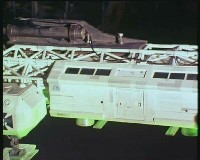
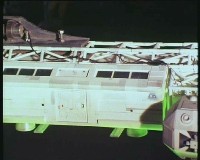
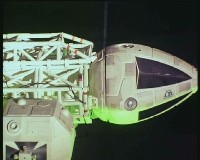

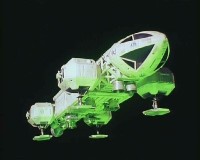
The following shots are only on the Fanderson DVD. Brian Johnson secures the nose cone of the Eagle ready for the shot. We clearly see how the Eagle is supported, and the lighting being reflected on the model. We also see the small 11 inch Eagle in detail, showing the unusual framework pattern.
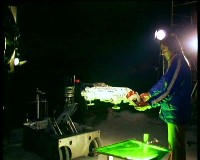

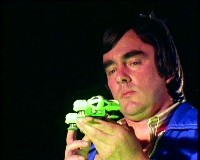

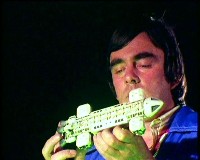
Space: 1999 copyright ITV Studios Global Entertainment